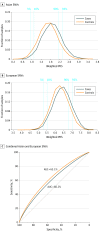Identification of Risk Loci for Parkinson Disease in Asians and Comparison of Risk Between Asians and Europeans: A Genome-Wide Association Study
- PMID: 32310270
- PMCID: PMC7171584
- DOI: 10.1001/jamaneurol.2020.0428
Identification of Risk Loci for Parkinson Disease in Asians and Comparison of Risk Between Asians and Europeans: A Genome-Wide Association Study
Abstract
Importance: Large-scale genome-wide association studies in the European population have identified 90 risk variants associated with Parkinson disease (PD); however, there are limited studies in the largest population worldwide (ie, Asian).
Objectives: To identify novel genome-wide significant loci for PD in Asian individuals and to compare genetic risk between Asian and European cohorts.
Design setting, and participants: Genome-wide association data generated from PD cases and controls in an Asian population (ie, Singapore/Malaysia, Hong Kong, Taiwan, mainland China, and South Korea) were collected from January 1, 2016, to December 31, 2018, as part of an ongoing study. Results were combined with inverse variance meta-analysis, and replication of top loci in European and Japanese samples was performed. Discovery samples of 31 575 individuals passing quality control of 35 994 recruited were used, with a greater than 90% participation rate. A replication cohort of 1 926 361 European-ancestry and 3509 Japanese samples was analyzed. Parkinson disease was diagnosed using UK Parkinson's Disease Society Brain Bank Criteria.
Main outcomes and measures: Genotypes of common variants, association with disease status, and polygenic risk scores.
Results: Of 31 575 samples identified, 6724 PD cases (mean [SD] age, 64.3 [10] years; age at onset, 58.8 [10.6] years; 3472 [53.2%] men) and 24 851 controls (age, 59.4 [11.4] years; 11 030 [45.0%] men) were analyzed in the discovery study. Eleven genome-wide significant loci were identified; 2 of these loci were novel (SV2C and WBSCR17) and 9 were previously found in Europeans. Replication in European-ancestry and Japanese samples showed robust association for SV2C (rs246814; odds ratio, 1.16; 95% CI, 1.11-1.21; P = 1.17 × 10-10 in meta-analysis of discovery and replication samples) but showed potential genetic heterogeneity at WBSCR17 (rs9638616; I2=67.1%; P = 3.40 × 10-3 for hetereogeneity). Polygenic risk score models including variants at these 11 loci were associated with a significant improvement in area under the curve over the model based on 78 European loci alone (63.1% vs 60.2%; P = 6.81 × 10-12).
Conclusions and relevance: This study identified 2 apparently novel gene loci and found 9 previously identified European loci to be associated with PD in this large, meta-genome-wide association study in a worldwide population of Asian individuals and reports similarities and differences in genetic risk factors between Asian and European individuals in the risk for PD. These findings may lead to improved stratification of Asian patients and controls based on polygenic risk scores. Our findings have potential academic and clinical importance for risk stratification and precision medicine in Asia.
Conflict of interest statement
Figures



Comment in
-
Parkinson disease risk variants in East Asian populations.Nat Rev Neurol. 2020 Sep;16(9):461-462. doi: 10.1038/s41582-020-0379-6. Nat Rev Neurol. 2020. PMID: 32572178 No abstract available.
-
Bilateral lower limb weakness: a cerebrovascular consequence of covid-19 or a complication associated with it?Intern Emerg Med. 2020 Aug;15(5):901-905. doi: 10.1007/s11739-020-02418-9. Epub 2020 Jul 2. Intern Emerg Med. 2020. PMID: 32617903 Free PMC article. No abstract available.
References
-
- Dorsey ER, Elbaz A, Nichols E, et al. ; GBD 2016 Parkinson’s Disease Collaborators . Global, regional, and national burden of Parkinson’s disease, 1990-2016: a systematic analysis for the Global Burden of Disease Study 2016. Lancet Neurol. 2018;17(11):939-953. doi:10.1016/S1474-4422(18)30295-3 - DOI - PMC - PubMed
-
- Foo JN, Tan LC, Irwan ID, et al. . Genome-wide association study of Parkinson’s disease in East Asians. Hum Mol Genet. 2017;26(1):226-232. - PubMed
-
- Nalls MA, Blauwendraat C, Vallerga CL, et al. ; 23andMe Research Team; System Genomics of Parkinson’s Disease Consortium; International Parkinson’s Disease Genomics Consortium . Identification of novel risk loci, causal insights, and heritable risk for Parkinson’s disease: a meta-analysis of genome-wide association studies. Lancet Neurol. 2019;18(12):1091-1102. doi:10.1016/S1474-4422(19)30320-5 - DOI - PMC - PubMed
Publication types
MeSH terms
Substances
LinkOut - more resources
Full Text Sources
Other Literature Sources
Medical
Molecular Biology Databases

